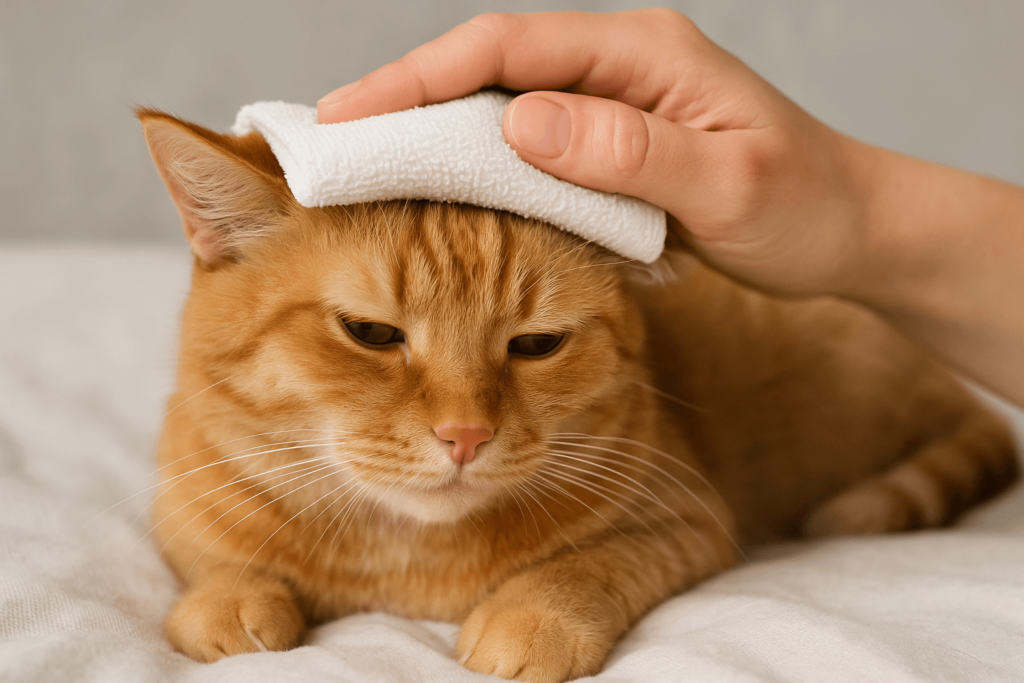Cat Fever Treatment: What Every Cat Owner Should Know
Fever in cats, also known as pyrexia, is a common symptom of underlying health issues and should never be ignored. While a mild fever can sometimes indicate your cat’s immune system fighting off an infection, prolonged or high fevers require immediate attention to prevent complications. Understanding the signs, causes, and treatment options for cat fever is essential for ensuring your feline friend stays healthy and comfortable. In this guide, we’ll explore everything you need to know about identifying and managing fever in cats, from home care tips to when to seek veterinary assistance.
Recognizing the Signs of Fever in Cats
Detecting a fever in cats isn’t always straightforward, as they are masters at hiding discomfort. However, certain signs can help you identify when your cat might be running a temperature.
Lethargy and Weakness:
A cat with a fever may seem unusually tired or reluctant to move, indicating they’re not feeling well.Loss of Appetite:
Cats often lose interest in food when they have a fever, which can lead to dehydration if left unaddressed.Warm Ears and Paws:
Feeling your cat’s ears or paws can give you a clue—warmth in these areas may suggest a fever.Shivering or Panting:
Shivering or rapid breathing can occur as your cat’s body tries to regulate its temperature.Behavioral Changes:
Increased irritability, hiding, or avoiding interaction are subtle signs that something might be wrong.
By paying close attention to these symptoms, you can act promptly to address your cat’s fever and ensure their comfort.

Common Causes of Fever in Cats
A fever is typically a sign that your cat’s body is responding to an infection, injury, or other health issue. Understanding the potential causes can help you and your vet determine the best course of action.
Bacterial Infections:
Bacterial infections, such as urinary tract infections or abscesses, are common culprits behind fever in cats.Viral Diseases:
Viruses like feline calicivirus or feline leukemia virus (FeLV) can trigger fevers as part of the immune response.Inflammatory Conditions:
Conditions like pancreatitis or inflammatory bowel disease may cause systemic inflammation, leading to fever.Toxin Exposure:
Ingesting toxic substances, such as plants or household chemicals, can result in fever as the body attempts to detoxify.Trauma or Injury:
Physical injuries, including bites or wounds, can cause localized infections that elevate body temperature.
Identifying the root cause of your cat’s fever is crucial for effective treatment and recovery.
Check this guide 👉What Causes Fever in Cats? Best 7 Expert Tips!
Check this guide 👉How Can You Tell If a Cat Has a Fever? Best 7 Expert Tips!
Check this guide 👉Cat Scratch Fever: Best 7 Expert Tips!
Signs of Fever in Cats | Possible Causes of Fever |
|---|---|
Lethargy and weakness | Bacterial infections |
Loss of appetite | Viral diseases |
Warm ears and paws | Inflammatory conditions |
Shivering or panting | Toxin exposure |
Behavioral changes | Trauma or injury |
How to Treat Cat Fever at Home
While professional veterinary care is essential for persistent or severe fevers, there are steps you can take at home to support your cat’s recovery.
Monitor Temperature Regularly:
Use a pet-safe thermometer to check your cat’s rectal temperature, aiming for a range of 100.5°F to 102.5°F (38°C to 39.2°C).Provide Hydration:
Ensure your cat has access to fresh water at all times, as dehydration can worsen their condition.Encourage Rest:
Create a quiet, cozy space where your cat can rest undisturbed while recovering.Offer Nutritious Food:
Tempt your cat with wet food or treats to encourage eating, which supports their immune system.Avoid Self-Medicating:
Never give human medications like aspirin or ibuprofen to your cat, as these can be toxic.
Home care can complement veterinary treatment but should not replace professional advice for serious cases.
When to Seek Veterinary Care for Cat Fever
Knowing when to consult a veterinarian is critical for addressing fever in cats effectively. Delaying treatment can lead to complications or worsening conditions.
High or Prolonged Fever:
A temperature above 103°F (39.4°C) or lasting more than 24 hours requires immediate attention.Severe Symptoms:
Difficulty breathing, seizures, or collapse are red flags that demand urgent care.Unexplained Weight Loss:
Significant weight loss alongside fever may indicate a chronic illness needing diagnosis.Refusal to Eat or Drink:
If your cat hasn’t eaten or drunk water for over 24 hours, dehydration becomes a serious concern.Recent Trauma or Injury:
If your cat has been injured or exposed to toxins, seek veterinary help promptly to rule out infection.
Timely intervention ensures your cat receives the care they need to recover fully.
Preventive Measures to Avoid Cat Fever
Preventing fever in cats starts with maintaining their overall health and minimizing exposure to risks. These proactive steps can reduce the likelihood of illness.
Keep Vaccinations Up-to-Date:
Regular vaccinations protect your cat against viral diseases that could cause fever.Maintain a Clean Environment:
Regularly clean your cat’s living space to minimize exposure to bacteria and viruses.Provide a Balanced Diet:
A nutritious diet strengthens your cat’s immune system, helping them fight off infections.Supervise Outdoor Time:
Monitor outdoor activities to prevent injuries or encounters with sick animals.Schedule Routine Vet Checkups:
Annual wellness exams allow your vet to detect potential issues before they escalate.
Taking preventive measures reduces the chances of your cat developing a fever and promotes long-term health.
Common Misconceptions About Cat Fever
There are several myths surrounding fever in cats that can lead to confusion or improper care. Clearing up these misconceptions ensures better decision-making.
Myth: All Fevers Are Dangerous:
Fact: Mild fevers can be part of the immune response and resolve naturally without intervention.Myth: Human Medications Are Safe for Cats:
Fact: Many human medications are toxic to cats and should never be administered without veterinary approval.Myth: A Warm Nose Means Fever:
Fact: A warm nose alone isn’t a reliable indicator of fever; internal temperature measurement is necessary.Myth: Fevers Always Indicate Serious Illness:
Fact: Sometimes, fevers are short-lived responses to minor infections or stress.Myth: Cats Can’t Survive High Fevers:
Fact: With timely veterinary care, most cats recover fully from even high fevers.
Understanding the truth behind these myths helps you make informed choices about your cat’s health.
Supporting Your Cat’s Recovery After Fever
Once your cat’s fever subsides, supporting their recovery ensures they regain full strength and vitality. These tips can aid in their healing process.
Gradual Reintroduction to Activity:
Allow your cat to ease back into their usual routine rather than rushing them into strenuous play.Hydration is Key:
Continue offering plenty of fresh water to replenish fluids lost during the fever.Monitor for Relapse:
Watch for recurring symptoms, such as lethargy or loss of appetite, which may indicate unresolved issues.Provide Comfort:
Keep your cat’s environment calm and stress-free to promote relaxation and healing.Follow-Up with Your Vet:
Schedule a follow-up appointment to confirm your cat’s complete recovery and address any lingering concerns.
By focusing on post-fever care, you can help your cat bounce back quickly and enjoy a happy, healthy life.
Frequently Asked Questions About Cat Fever Treatment
What is considered a normal temperature for cats?
A normal temperature for cats ranges from 100.5°F to 102.5°F (38°C to 39.2°C).
Can I use a human thermometer on my cat?
Yes, but only a digital thermometer designed for rectal use is safe for cats.
How can I tell if my cat has a fever without a thermometer?
Look for warm ears, lethargy, shivering, or behavioral changes as potential indicators.
Are fevers dangerous for cats?
Mild fevers can be harmless, but prolonged or high fevers may indicate serious health issues.
What should I do if my cat’s fever doesn’t go down?
Contact your veterinarian immediately, as persistent fever may require diagnostic tests or medication.
Prioritizing Your Cat’s Health During Fever Episodes
Fever in cats is a signal that something isn’t quite right, whether it’s an infection, injury, or another underlying issue. By recognizing the signs early, understanding the causes, and knowing how to respond, you can play an active role in your cat’s recovery. Remember, while home care can provide temporary relief, veterinary expertise is indispensable for diagnosing and treating the root cause of the fever. With prompt attention and proper care, your feline companion will soon be back to their playful, purring self.
Understanding Bone Supplement for Cats: Best 7 Expert Tips! – Safe, vet-approved guidance for strong feline bones & balanced nutrition.
Bone Supplement for Dogs: Best 7 Expert Tips! – Expert guide to calcium, collagen & bone health for every life stage.
Understanding Can Cats Get Sunburn: Best 7 Expert Tips! – Protect your feline from UV damage with vet-backed prevention strategies.
How to Train a Seizure Alert Dog: Best 7 Expert Tips! – Learn expert-backed steps to nurture natural instincts into reliable, life-saving seizure alerts.





